THE HISTORY OF TUNGSRAM 1896-1945 - MEK
THE HISTORY OF TUNGSRAM 1896-1945 - MEK
THE HISTORY OF TUNGSRAM 1896-1945 - MEK
- No tags were found...
You also want an ePaper? Increase the reach of your titles
YUMPU automatically turns print PDFs into web optimized ePapers that Google loves.
65 <strong>TUNGSRAM</strong>lamp. The first mushroom-shaped bulbs were handmadein the Research Laboratory. In 1934, when<strong>TUNGSRAM</strong> informed its PHOEBUS partners of itsplans to go ahead with the production of krypton-filledlamps, the more extensive experiments necessitatedtheapplicationof machines in the production of bulbs.In the Summer of 1934 <strong>TUNGSRAM</strong> informed itsfellow cartel members on a meeting held in Ujpestabout the success of the experiments and the company'sintention to produce krypton lamps. The twodirectors representing Philips, Dr. Geiss and Lokker,made a counter-announcement. They told that Philipswas about to market the argon-filled lamp fitted withdouble-coiled filament. Since the experiments to developdouble-coiled filaments based on the Millner-Tury type GK-tungsten proceeded satisfactorily inUjpest, <strong>TUNGSRAM</strong> announced its plans to producekrypton lamps fitted with double-coiled filament as anovelty. (The first experimental krypton lamps still hadsingle-coiled filaments.) No gas-filled candle andspherical shaped lamps had previously been producedfor industrial decoration. Therefore, great successcould be expected from the candle shaped and decorativelamps filled with gas (krypton) and fitted withdouble-coiled filament. The experiments showed afifty percent improvement on the earlier lamps of thesame size. The candle and spherical shaped lampswith opaque glass were brought out bearing this inmind. These lamps with their white light and minimalloss of luminous power later proved very popular withthe public.The experiments, again, showed that the candleshapedkrypton lamps had a few (1—2—3) percenthigher luminous efficiency than the mushroomshapedkrypton lamps of the same coiled filament,when calculated over their 1000 hour useful life. Thisgave the idea for replacing the mushroom-shapedlamps with ellipsoid ('plum') shaped ones which approximatedthe candle shape more. Such bulbs werebetter cooled by the air flowing upwards along theglass, so it was possible to design even smaller lamps.This, in turn, promised further savings on krypton.But the mass-production of krypton lamps was still along way off from the first experimental products,although their better luminous efficiency, as well astheir other advantages, were all justified in the tests.By far the greatest obstacle on this road was the highprice of krypton. For the production of the first experimentallamps the company finally managed to buy thenecessary krypton for 800 German Marks a litre — andeven that only after Osram had intervened on<strong>TUNGSRAM</strong>'S behalf! According to <strong>TUNGSRAM</strong>'Sown estimates the price of krypton used in lampswhich could be sold on the market for a realistic pricecould not exceed 6 German Marks per litre! (Theexchange rate of German Marks and Pengos in commercialtransactions fluctuated between 1.36 and 1.63)The scientific experiments aiming to solve the problemsof the industrial production of krypton wereassociated with equally complicated business negotiations.As ImreBrody himself wrote in a note to the chiefexecutive on 14th July, 1932: "In the matter of thekrypton lamps we have reached the point where themost important questions are not the technical but thecommercial ones."The work of competent scientific researchers in itselfwould not have been sufficient to achieve the massproductionof krypton lamps in Hungary; the kind offar-sighted and bold company management was alsoneeded which <strong>TUNGSRAM</strong> was lucky to have at thetime.In the matter of purchasing krypton, <strong>TUNGSRAM</strong>contacted the companies of Linde, Air Liquide and I.G.Farbenindustrie. I.G. Farbenindustrie turned down<strong>TUNGSRAM</strong>'S offer, but the other two companiesthought it possible that their existing oxygen plantscould deliver 10—20 m^ krypton gas, although theyregarded the price offer of 20 German Marks too low.The purchase of krypton became increasingly importantfor <strong>TUNGSRAM</strong>, to the company was exploring thepossibilities of setting up its own krypton producingplant. One of the most essential licenses of the process,which concerned the heat exchange componentsused in the regenerating phase, was owned by LindeCompany. When <strong>TUNGSRAM</strong> showed interest in thelicenses, Linde gave a very poor opinion on the








![Letöltés egy fájlban [4.3 MB - PDF]](https://img.yumpu.com/50159926/1/180x260/letaltacs-egy-fajlban-43-mb-pdf.jpg?quality=85)







